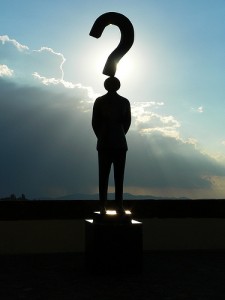
(For the audio version of this blog, please visit: http://brothersinchristcmf.org/wp-content/uploads/2023/04/Mass-Blog-for-Divine-Mercy-Sunday-2023.mp3)
Jesus’ favorite disciple doesn’t give us a very flattering image of fellow disciple Thomas Didymus. Sunday’s excerpt from John’s gospel (Jn 20:19-31) details how Thomas won his nickname “Doubting Thomas.” But before their master was crucified, John’s gospel showed us a Daring Thomas.
After their friend Lazarus dies, Jesus tells his disciples he’s glad he wasn’t there to save him because now he has the opportunity to relieve them ALL of any doubt of who their master is. But this would require a return trip to Judea, where Jesus was almost stoned to death. That didn’t seem to bother Thomas.
“Let us also go to die with him,” Thomas says.
Thomas had guts. So where was he after the crucifixion? John tells us the other disciples were cowering in their undisclosed location for fear of Jesus’ enemies. Considering Thomas’s whereabouts the first night the risen Christ appeared to his fellow disciples invites us to put ourselves in his place. We’d like to think we’d have the courage of our Master’s convictions and that we’d be starting to plan how we’d carry on without him.
Could Thomas’s guts have inspired him to start preparing to spread his master’s gospel? Is THAT what he was doing the night he was absent from the apostles’ undisclosed location?
Neither John’s nor any of the other canonical gospels tell us where Thomas was. But some scholars believe Thomas would eventually produce his own account of his time with Jesus and that he’d spread his gospel as far as India (where he was martyred). Although a gospel according to Thomas doesn’t appear in the Bible, one was found centuries ago, eventually joining other discovered writings as apocryphal, even gnostic, gospels (separate from the inspired books of our Bible).
What our first reading this Sunday from the Acts of the Apostles (Acts 2:42-47) does tell us about what happened after Jesus’ post-resurrection appearance to them, and after his ascension, is that they got right to work convincing future “Doubting Thomases” that their master is still the way, truth, and life. In Sunday’s second reading (1 Pt 1:3-9), Peter—the one who denied knowing Jesus during his Master’s passion—tries keeping us from making the same mistakes of denial he and Thomas did:
Although you have not seen him you love him; even though you do not see him now yet believe in him, you rejoice with an indescribable and glorious joy,
as you attain the goal of your faith, the salvation of your souls.
One of the major Acts of the Apostles was to offer a seat to future disciples at many more suppers that would follow the last one over which Jesus presided. Sunday’s first reading tells us how they got started.
They devoted themselves to the teaching of the apostles and to the communal life, to the breaking of bread and to the prayers. … They ate their meals with exultation and sincerity of heart, praising God and enjoying favor with all the people. And every day the Lord added to their number those who were being saved.
But even the saved can suffer doubt. At the last meal the apostles shared with Jesus, when he assured them they’d be able to follow him to the place he was preparing for them, Thomas said “Master, we do not know where you are going; how can we know the way?” Jesus replied: “I am the way and the truth and the life. No one comes to the Father except through me.”
Whether or not Thomas doubted that, and however the courage of their convictions eventually defeated any doubts remaining among any of them, we 21st Century disciples have the opportunity to be Thomas’s twin. He found the strength to let the light of faith eliminate any shadows of doubt remaining in his heart’s hiding places.
–Tom Andel